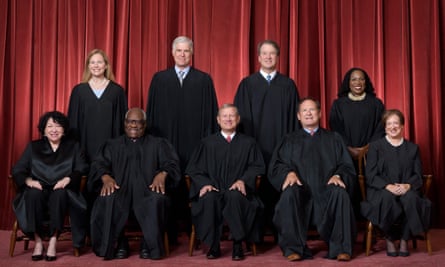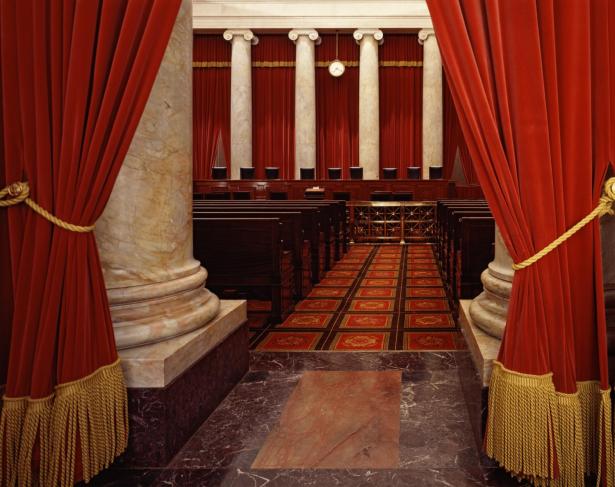The US supreme court will gather on Monday at the start of a new judicial term that has the potential to catastrophically disrupt the functioning of government, expand the assault on reproductive rights and unleash yet more gun violence on an already reeling America.
When the nine justices convene on Monday morning it will mark the start of the third full term in which the 6-3 rightwing supermajority created by Donald Trump is in command. Explosive rulings delivered over the past two terms have demonstrated the conservatives’ newfound muscle, stripping millions of Americans of fundamental rights from abortion to affirmative action.
Three significant cases before the court this term cut to the core of the functioning of the US government itself. According to the co-hosts of the Strict Scrutiny podcast, at stake is no less than “the future of government as we know it”.
On Tuesday the court will hear oral arguments in a case that poses the greatest threat to consumer protections for decades. Stephen Vladeck, an authority on constitutional law at the University of Texas law school, said that although CFPB v CFSA is technical in its framing, it has the potential to “bring down much of the American financial system”.
The case is the culmination of at least a decade of sustained effort by groups to “declare war”, as Trump’s former chief strategist Steve Bannon put it, on the administrative state. The focus is the Consumer Financial Protection Bureau (CFPB), the government agency conceived by the Harvard law professor and now US senator Elizabeth Warren that regulates banks, credit unions, payday lenders and other financial entities.
Since its inception in 2011, the CFPB has been a target of the far-right legal movement under the leadership of the co-chairman of the Federalist Society Leonard Leo. Seven amicus briefs supporting the CFPB challenge have been lodged with the supreme court by groups associated with Leo.
The current assault on the CFPB has been channeled through the Community Financial Services Association of America (CFSA) which represents payday loan companies. “This is a well-coordinated campaign by predatory lenders aligned with rightwing groups who want to bring down a regulatory body standing up for everyday Americans,” said Liz Zelnick of Accountable.US, a nonpartisan anti-corruption watchdog.
A ruling from the fifth circuit last year came up with a novel theory that had never before been espoused by any other court. It found that the way the CFPB is funded, not directly through Congress but via the federal reserve, violates the appropriations clause of the constitution.
The argument, should it be affirmed by the supreme court, would render the CFPB itself unconstitutional and strip it of all authority. The implications go much further – several other critical government programs, including social security and Medicare, are similarly funded outside congressional appropriations.
“Where does this end, and what might be next?” asked Joe Gaeta of the national legal organization Democracy Forward. “There’s no logical stopping point for how this funding argument could be used in other contexts.”
Two other cases could have significant implications for the workings of government. Loper Bright Enterprises v Raimondo challenges a 40-year precedent set by the supreme court itself in Chevron that gives federal agencies the power to regulate key areas of public life including the environment and labor rights.

The nine supreme court justices in 2022. The 2023-24 term stands out for the number of contentious cases which originate from the most radical rightwing judicial panel in the nation, the fifth circuit court of appeals. Photograph: Fred Schilling/Collection of the Supreme Court/AFP/Getty Images
The Securities and Exchange Commission is also in the cross hairs in a case that would undermine the power of federal agencies to enforce their own policies in-house without recourse to jury trials or congressional legislation.
The new 2023-24 term stands out not only because of the extreme rightwing measures the justices are considering, but also because of where those cases originated. Many of the most contentious issues, spanning from attacks on federal government regulators to abortion and gun rights, have bubbled up from the fifth circuit court of appeals – the most radical rightwing judicial panel in the nation.
The arguments generated by the fifth circuit are testing the legal boundaries of US constitutional law. In turn, they are putting the supreme court’s new supermajority of conservatives justices to the test: just how far are they prepared to go in reconfiguring the legal landscape of America?
“This term is really a referendum on whether the supreme court is willing to endorse the most reactionary impulses of certain lower federal courts, especially the fifth circuit,” Vladeck said.
The fifth circuit covers the deep south states of Texas, Louisiana and Mississippi, and as such has always had a conservative bent. But the court took a drastic lurch to the right under the presidency of Trump, who appointed six of its 17 active judges.
Three of the other huge cases that are likely to define the upcoming supreme court term have also come from the fifth circuit. In August, the appeals court sharply curtailed the availability of the abortion pill mifepristone in an order that would prohibit distribution of the medication online and by mail.
The drug, which is used in more than half of US abortions, remains on the market while the appeals process continues. It is widely expected that the supreme court will take the case and make a final ruling.
In June 2022 the supermajority moved to loosen America’s already lax gun laws. Now it has agreed to take a major case, United States v Rahimi, which considers whether second amendment rights allow guns to be owned even by people under restraining orders for domestic violence.
In February the fifth circuit, in an opinion written by a Trump appointee, struck down the ban on people under such restraining orders bearing firearms. The court found that Zackey Rahimi’s gun rights were violated when he was sentenced to six years in prison for possession of several firearms while under a restraining order.
The appeal court’s decision was an outlier considering Rahimi’s track record. He was put under the restraining order because he allegedly assaulted his girlfriend and threatened to shoot her, having also been involved in five shootings in Texas.
Almost half of all women murdered in the US are the victims of current or former partners, and of those partner killings more than half are committed using firearms.
The fingerprints of the fifth circuit are also to be found on another big case before the supreme court regarding misinformation on social media platforms. Earlier this month a three-judge panel of the court upheld an injunction barring contact between the Biden administration and social media companies.
The administration had engaged in a joint attempt with the platforms to counter misinformation around elections, the Covid pandemic and other matters of public interest. The fifth circuit, however, ruled that the effort was a breach of the first amendment right to free speech.
All these highly contentious cases arrive at the supreme court at a time when public approval in the court is at an historic low. The latest poll from Gallup in August found that a dismal 40% approved of the way the justices operated.
Over the summer there has been an almost constant drumbeat of ethics scandals involving some of the justices, especially the rightwing stalwarts Clarence Thomas and Samuel Alito. In the latest blockbuster from ProPublica, Thomas was revealed to have participated in donor events held by the rightwing alliance the Koch network.
So far, the justices have proved to be resistant to mounting demands for them to adopt a code of ethics – a form of accountability required for all other judges. But Renee Knake Jefferson, a law professor specializing in ethics at the University of Houston, said she was “cautiously optimistic” that a resolution was getting closer.
“Several justices have said that they have been talking about the ethics code they might adopt, and that they are trying to come to consensus,” she said.
Ed Pilkington is chief reporter for Guardian US. He is the author of Beyond the Mother Country. Twitter @edpilkington.


Spread the word